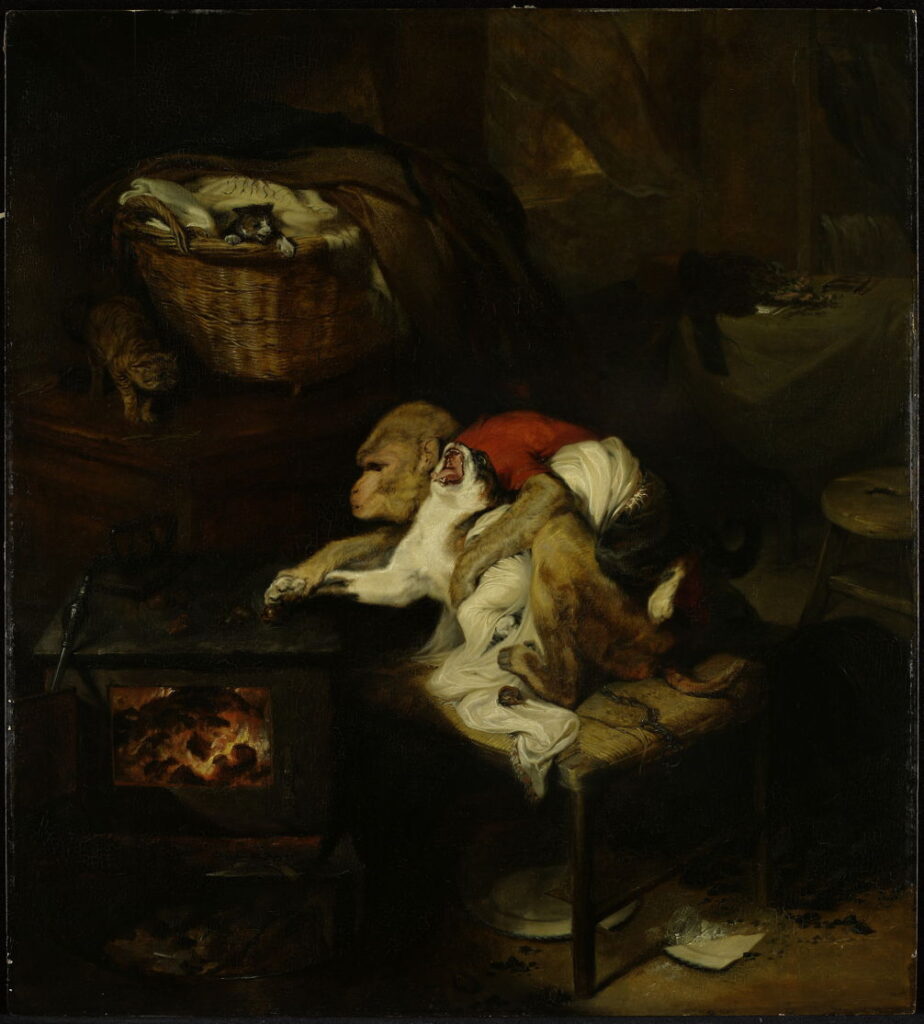Reading visual art: 142 Apes and monkeys, narrative

Monkeys and apes are some of the oldest motifs in European painting, and have been significant features in every century’s art since the 1400s. Until little more than a century ago, though, they were only human-like, and not considered to be our nearest relatives.
Artist not known, Blue Monkeys (before c 1627 BCE), fresco, dimensions not known, Prehistoric Museum of Thira, Santorini, Greece. Image by Bernard Gagnon, via Wikimedia Commons.
The earliest known example of monkeys in European art is this lavish fresco of Blue Monkeys found in the ruins of Thera, on the modern island of Santorini in Greece. This Cycladic civilisation was destroyed by a massive volcanic explosion in about 1627 BCE, so we know that these paintings are well over 3,500 years old.
Artist not known, Blue Monkeys (detail) (before c 1627 BCE), fresco, dimensions not known, Prehistoric Museum of Thira, Santorini, Greece. Image by Olaf Tausch, via Wikimedia Commons.
Although now known as the fresco of the Blue Monkeys, these images make them look rather grey, and that may have been their intended colour. Presumably these monkeys had been introduced locally from North Africa.
The ruins on Santorini weren’t excavated until very recently, and these blue monkeys were concealed for the period from 1627 BCE until the late 1960s. Despite that, the next notable appearance of monkeys in European art shows animals that are eerily similar.
Sandro Botticelli (1445-1510), Deer and Monkeys (c 1470), reverse of ‘Judith with the Head of Holofernes’, media and dimensions not known, Cincinnati Art Museum, Cincinnati, OH. Wikimedia Commons.
The reverse of Botticelli’s painting of Judith with the Head of Holofernes bears an unfinished work from about 1470 that has been given the title of Deer and Monkeys. Where the artist had seen these pale blue monkeys isn’t clear, although the background landscape shows a coastline on the Mediterranean.
Monkeys are sometimes included in assemblies of different species, such as those of the Garden of Eden.
Cornelis van Haarlem (1562–1638), The Fall of Man (1592), oil on canvas, 273 x 220 cm, Rijksmuseum Amsterdam, Amsterdam, The Netherlands. Wikimedia Commons.
At the end of the seventeenth century, Cornelis van Haarlem’s wonderful painting of The Fall of Man (1592) counts a monkey in with the many different species it shows in the Garden of Eden. These include familiar species such as dog, fox, sheep, cat, frog, and snail.
Cornelis van Haarlem (1562–1638), The Fall of Man (detail) (1592), oil on canvas, 273 x 220 cm, Rijksmuseum Amsterdam, Amsterdam, The Netherlands. Wikimedia Commons.
Between the legs of Adam and Eve is a touching passage of a small monkey embracing a cat. There are obvious relationships between the monkey and Adam, and between the cat and Eve, but van Haarlem may also have been invoking the fable of the cat’s paw.
Edwin Henry Landseer (1802–1873), The Cat’s Paw (c 1824), oil on panel, 76.2 × 68.8 cm, Minneapolis Institute of Art, Minneapolis, MN. Wikimedia Commons.
Edwin Henry Landseer’s account of the fable of The Cat’s Paw from about 1824 shows the moment of climax in the retelling by Jean de La Fontaine in 1679. Bertrand the monkey is roasting chestnuts in the embers of a fire. Rather than risk burning himself retrieving the nuts from the heat, he promises Raton the cat a share of them if the cat will scoop them out for him. The cat agrees: as Bertrand eats the chestnuts when they emerge from the fire, the cat’s paw becomes more and more burned. Before the cat can claim its reward, they’re disturbed by a maid. The monkey then profits from the cat’s efforts and suffering, but the cat is cheated from enjoying its share. Landseer shows the chestnuts roasting on the top of a stove, and the monkey using the cat’s paw to hook them back in to him, as the cat wails in pain.
Agostino Carracci (1557–1602), Hairy Harry, Mad Peter and Tiny Amon (1598-1600), oil on canvas, 101 x 133 cm, Museo di Capodimonte, Naples, Italy. Wikimedia Commons.
Painters have long been attracted to the spectacle of humans who look different. In Agostino Carracci’s case, he combined three strange examples in his Hairy Harry, Mad Peter and Tiny Amon, completed between 1598-1600, not long before his death. From the left are Tiny Amon (Rodomonte) the dwarf, Arrigo Gonzalez the hirsute (Hairy Harry) from the Canary Islands, and Mad Peter (Pietro the buffoon). Accompanying them are a large parrot, a couple of dogs, and two monkeys.
Clara Peeters (fl 1607-1621), Still Life of Fruit, Dead Birds and a Monkey (1615-20), oil on panel, 47.4 x 65.6 cm, Private collection. Wikimedia Commons.
Monkeys were also relatively common in Vanitas paintings, such as Clara Peeters’ Fruit, Dead Birds and a Monkey (1615-20). A monkey is busy feeding from nuts, while gazing at a small pile of dead birds. I’m not sure how monkeys fit in with the symbolic associations with death in Vanitas compositions, though.
They have had other more symbolic associations, typically with mischief and mayhem.
Pierre Bonnard (1867-1947), Pleasure (1906), oil on cardboard, 250 x 300 cm, Private collection. The Athenaeum.
In Pierre Bonnard’s large painting of Pleasure or Games from 1906, one of four panels he made for Misia and Alfred Edwards’ apartment in Paris, decorative edging includes images of birds and monkeys, whose innocent playfulness is seen as being pleasurable.
Lovis Corinth (1858–1925), The Temptation of Saint Anthony (after Gustave Flaubert) (1908), oil on canvas, 135.3 × 200.3 cm, The Tate Gallery, London. Wikimedia Commons.
One monkey appears in the riotous assembly shown in Lovis Corinth’s painting of The Temptation of Saint Anthony from 1908. This radically different depiction of this episode in the saint’s life was painted after Gustave Flaubert, and exceptionally shows Anthony as a young man, a highly inventive account.



